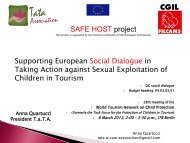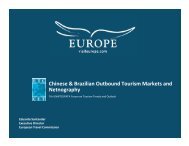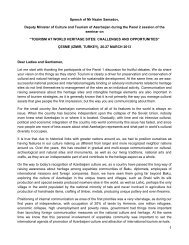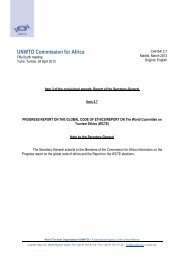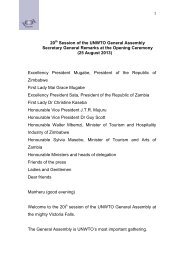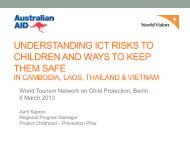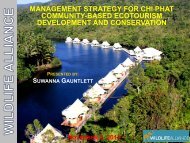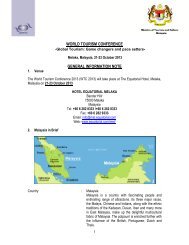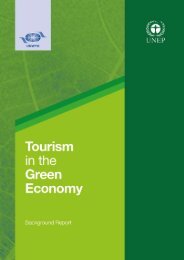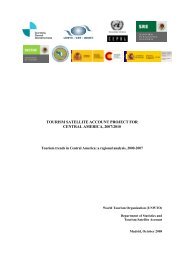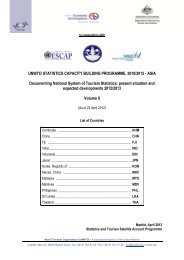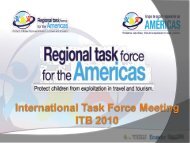A Manual for Water and Waste Management - World Tourism ...
A Manual for Water and Waste Management - World Tourism ...
A Manual for Water and Waste Management - World Tourism ...
Create successful ePaper yourself
Turn your PDF publications into a flip-book with our unique Google optimized e-Paper software.
4. WATER CONSERVATION AND REUSE<br />
4.1 Determining the Nature of the Problems<br />
Be<strong>for</strong>e an effective water <strong>and</strong> wastewater management plan can be designed, tourist<br />
facility providers must conduct an audit to determine the type <strong>and</strong> amount of<br />
wastewater being generated <strong>and</strong> to assess water use, reuse <strong>and</strong> treatment practices<br />
being followed.<br />
Issues that should be addressed to help identify problems include:<br />
Assess current wastewater treatment practice be<strong>for</strong>e water is discharged<br />
whether to:<br />
On-site treatment facility<br />
Municipal treatment facility<br />
Identification of where wastewater is generated within a tourism facility<br />
Determine whether discharged wastewater quality meets effluent st<strong>and</strong>ards (if<br />
they exist)<br />
Identify whether on-site wastewater treatment is used <strong>for</strong> non-potable<br />
applications (if applicable)<br />
Assess complaints from customers <strong>and</strong> residents about reclaimed wastewater<br />
quality, e.g. kind <strong>and</strong> nature of odors or other suspended impurities<br />
Once the situation has been assessed, a range of approaches <strong>and</strong> techniques to deal<br />
with wastewater can be considered. This work must be done by a water quality <strong>and</strong><br />
wastewater engineer.<br />
4.2 Conservation of <strong>Water</strong><br />
The more water used by a facility the more wastewater is generated. Optimizing water<br />
consumption can help minimizing wastewater <strong>and</strong> also reduce the energy required to<br />
treat the water. The following is a list of questions on water usage that a facility should<br />
consider in order to be able to develop priority areas of actions in dealing with water<br />
use conservation.<br />
Have any water saving practices been taken <strong>for</strong> the last twelve months?<br />
Is water use monitored?<br />
Is the water system regularly checked <strong>for</strong> leaks or surges in consumption?<br />
Are staff encouraged to save water?<br />
Are guests encouraged to save water?<br />
Does the tourism facilities have any water intensive activities e.g. swimming<br />
pool, garden <strong>and</strong> laundry services?<br />
Have the water efficiency equipment been used?<br />
There are two major ways to minimize water consumption in most facilities.<br />
Reducing water loss:<br />
Overall water consumption can be reduced by following good water<br />
management practices by regularly repairing equipment, fixing leaky taps,<br />
turning off equipment when not in use <strong>and</strong> replacing faulty/old equipment. To<br />
facilitate these tasks, leak detection instrumentation is commercially available.<br />
The flow rates of conventional faucets vary from 10-15 liters per minute. A leaky<br />
faucet, dripping one drop per second, can waste 135 liters of water daily. Flow<br />
27



